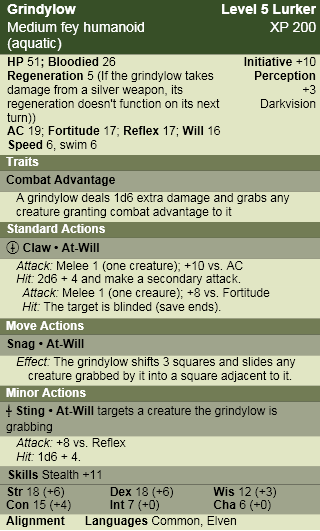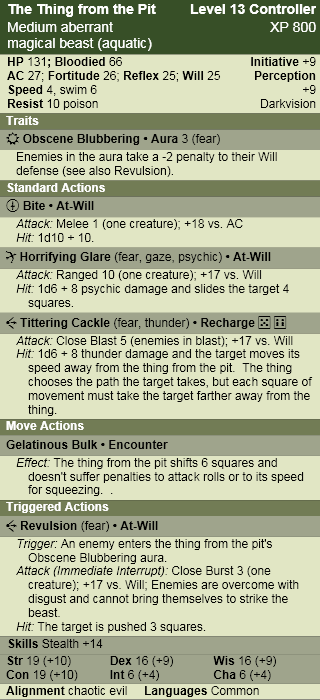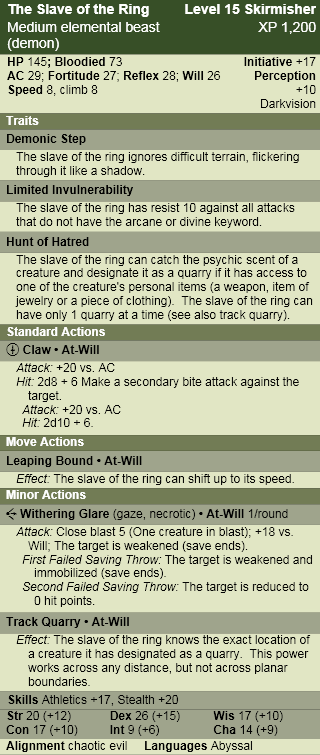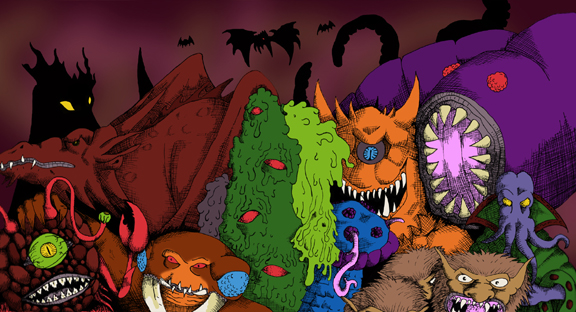Posts Tagged ‘Original Art’
The Slithering Shadow
February 24, 2011The Slithering Shadow features many elements that became synonymous with weird fantasy and were later incorporated into D&D: radiant gems, cultures that are near extinct thanks to their own decadence (the yuan-ti, kopru and bullywugs come to mind), and horrible monsters worshipped as gods. In fact, almost everything from the module B4 The Lost City is taken directly from this story (the desert, the adventure hook, the drug use and even the monster at the end). For these reasons the story is worth reading (and is exceedingly readable), there was just one thing that irked me – Natala, the female protagonist. Even more than the last story (where Yasmela is at least a capable ruler), Natala is a one dimensional damsel in distress. I don’t think the character ruins the story, but it’s unfortunate, since I know Howard is a better writer than that.
One last thing, I’m not really sure what ‘cosmic lust’ is, but the line is used in this story and has forever been linked to The Slithering Shadow’s monster… and just might be the inspiration for countless Japanese hentai movies.
Spoiler Alert! All of these Hyborian age posts are going to be filled with spoilers. From the summary, to the monster stats they are going to ruin any surprises as to what the monster is, when they pop up in the story and how and why they are killed. You’ve been warned.
Summary
This story takes place sometime in the middle of Conan’s career, during his tenure as a mercenary, probably after the events in Black Colossus.
Conan and Natala, a Brythunian Conan had rescued from a raided Shemitish slave market, find themselves without food and water, lost in the deserts east of Stygia. The pair are all that remains of a failed invasion of Stygia by Almuric, a rebel prince of Koth. With no hope of survival, Conan prepares to spare Natala an agonizing death by dehydration with a merciful sword stroke, but his hand is stayed by the image of a city in the distance.
The strange city is constructed from an eerie, green, glass-like material, and the main gates have been left unlocked. Inside, Natala and Conan find a guard who appears to be dead, but rouses from his torpor and attacks. Conan slays the madman, but the expected alarm isn’t raised, and no one else seems to be about on the city streets.
More exploration reveals other oddities, as well as the beautiful Stygian, Thalis. The stranger takes a liking to Conan, and enlightens the refugees over a meal. An outsider, Thalis came to the city of Xuthal as a child, and learned the city’s strange ways. Xuthal was founded by people from the east, learned philosophers whose science is able to produce food without farms, and radium gems whose touch brings lig ht to a room. But generations of leisure have led the culture to stagnate in decadence. The citizens spend most of their days and nights in a drug induced haze. They worship a horrible monster, Thog, who lives in the catacombs beneath the city and rises to feed on its sleeping inhabitants. That Xuthal’s people would accept death so fatalistically outrages Conan.
ht to a room. But generations of leisure have led the culture to stagnate in decadence. The citizens spend most of their days and nights in a drug induced haze. They worship a horrible monster, Thog, who lives in the catacombs beneath the city and rises to feed on its sleeping inhabitants. That Xuthal’s people would accept death so fatalistically outrages Conan.
Thalis desires Conan to stay, for she sees in the barbarian both a lover and a powerful tool for Xuthal’s conquest. Only the presence of Natala stands in the Stygian’s way, so Thalis kidnaps her and flees to the tunnels underneath the city via a secret passage.
Instead of leaving the bound Natala for Thog, Thalis decides to torture her captive as revenge for the wounds she suffered during the struggle.
Meanwhile, Conan works his way through the maze-like rooms and corridors of Xuthal, fighting with the roused inhabitants on the way.
By the time Conan reaches the catacombs, Thog has already devoured Thalis and is about to take his companion as well. Fearlessly, the barbarian launches into the monster, driving it away from Natala. The brutal battle sends a wounded Thog fleeing to the deepest reaches of the earth and leaves Conan beaten, torn and poisoned.
Together, Conan and Natala stumble their way into a quiet part of the city were the Brythunian is able to administer a stolen draught of golden elixir that purges the beast’s venom from Conan’s body.
Thog of Xuthal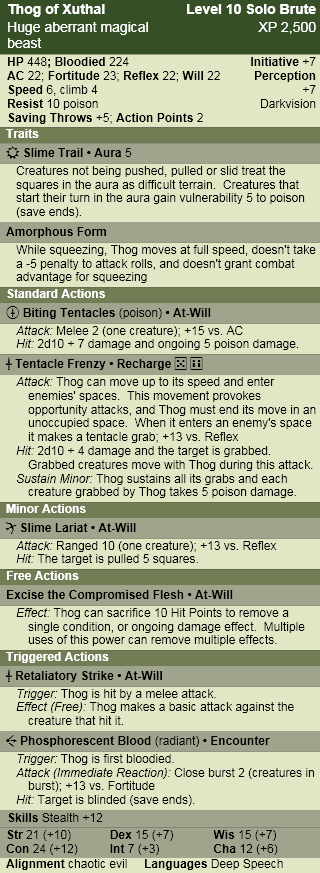
“It towered above him like a clinging black cloud. It seemed to flow about him in almost liquid waves, to envelop and engulf him… The thing seemed to be biting, clawing crushing, and clubbing him all at the same time. He felt fangs and talons rend his flesh; flabby cables that were yet hard as iron encircled his limbs and body, and worse than all, something like a whip of scorpions… tearing the skin and filling his veins with a poison that was like liquid fire.” – Robert E. Howard, The Slithering Shadow
Lore
Dungeoneering DC 20: In a sunken dome in the center of the legendary city of Xuthal, the monster known as Thog slumbers and is worshipped by the degenerate inhabitants as a god. The creature is so old that none can remember if it was brought to Xuthal by the city’s founders, or whether they unearthed it during the city’s construction.
Thog wakes at irregular intervals and stalks the secret corridors and catacombs of Xuthal, feeding on the sleeping inhabitants, who are content to await their doom in lotus dreams.
Thog of Xuthal in Combat
Thog is primarily motivated by hunger, and its preference for feeding on intelligent humanoids seems to suggest the creature needs more than just material nourishment to sustain its alien life. It attacks directly and fiercely, having lived so long it has forgotten the concept of death. In the unlikely event that Thog is gravely injured, it will retreat to its lair, where it is said there lies a well so deep it pierces the heart of the underdark.
Encounters
Thog spends much of its time in slumber, perhaps joining with its followers in one of the dream worlds the culture is so preoccupied with. Despite the creature’s predation, and even though they fear their god to the point of madness, the warriors of Xuthal protect the dome where the creature lairs and react violently to any incursion into the city from outsiders.
When hungry, Thog hunts alone, though creatures it shares a kinship with, like oozes and carrion crawlers, sometimes bubble up from the well in its lair and follow in Thog’s wake.
Notes:
My first solo monster! Many of the monsters Conan fights are solitary, but for some reason it seamed particularly appropriate for Thog to be a solo, especially given Howard’s description of it as “an aggregation of lethal creatures” (which mechanically is exactly what a solo creature is). I made it a level 10 challenge because I thought the monstrous god of a half-ruined city would be the perfect capstone to a series of heroic tier adventures.
I have to admit that creating a solo creature was difficult. Since each solo represents the xp of 5 normal creatures, there’s a lot expected out of a solo monster. I tried to follow Sly Flourish’s recommendations in ‘4 things every solo monster should have’, which I think is good advice, but may be a little heavy handed with the status effect protection. It’s true that a single daze or stun has a much greater impact on a solo encounter then it would in any other encounter, and could make a challenging fight into an unmemorable cakewalk, but take away these effects too indiscriminately and players will feel ripped off. What’s more, they’ll stop choosing those powers in favor of simple damage attacks, which also leads to boring combats (and nobody wants that). That’s why I chose to use the mechanic that I did. Challenge ruining effects can be ended, but at a cost (and only on the monster’s turn), and one I feel doesn’t leave the players feeling cheated. For the record I also think that Sly Flourish’s example is a good one, it’s just hard to apply some of the things he used to my case since he was working with an epic level monstrosity while I was looking to create a heroic challenge.
Black Colossus
February 3, 2011Black Colossus is most well known for containing many of the ideas and plot points that Howard later re-used for his Conan novel The Hour of the Dragon, but is, I think, an excellent story on its own. In particular, I love the introduction. It perfectly captures the feeling and tone of something that would later become integral to D&D: exploring dangerous, ancient ruins and disarming deadly traps.
Spoiler Alert! All of these Hyborian age posts are going to be filled with spoilers. From the summary, to the monster stats they are going to ruin any surprises as to what the monster is, when they pop up in the story and how and why they are killed. You’ve been warned.
Summary
In the three-thousand year old ruins of Kuthchemes, a Zamoran master thief breaks the seal on a strangely preserved ivory dome and releases the wizard Thugra Khotan from his long slumber. Thugra assumes the identity of ‘Natohk the veiled one’ (how very Alucard of him) and raises a horde of desert nomads and elite Kushite warriors. Hungry for conquest and revenge against the Hyborian peoples that overran his kingdom so long ago, Natohk heads north, towards the kingdom of Khoraja.
Before his army reaches its first target, Natohk torments Khoraja’s ruler, the princess Yasmela, with his dark magic. Desperate, Yasmela goes to the temple of Mitra for guidance. Here, the voice of the god tells the princess that her and her people’s only hope is for her to go into the street and place her kingdom in the hands of the first man she meets there.
As fate would have it, she runs into the mercenary Conan whom s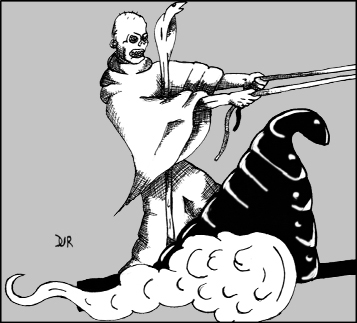 he gives control of the military. The nobles of Khoraja chafe at the idea of being led by a barbarian, but there is little choice, so the army rides out to meet Natohk’s nomads before the city is sieged.
he gives control of the military. The nobles of Khoraja chafe at the idea of being led by a barbarian, but there is little choice, so the army rides out to meet Natohk’s nomads before the city is sieged.
A titanic battle ensues, one where Conan has to face not only Natohk’s sorcery (he uses summoned mists to conceal troop movements and creates magical walls of flame), but also the arrogance and insubordination of Khoraja’s elite.
In the end, Conan’s superior tactics win the battle, but Natohk abducts Yasmela and speeds away on his demon drawn chariot with the Cimmerian in hot pursuit. The sorcerer blames the loss on his lust for the princess and intends to sacrifice her to restore his powers. Fortunately Conan arrives before he is able, hurling his sword and impaling Natohk before he can work any magic (and thus inspiring countless movies and comics where swords have been used as projectiles since).
Thugra Khotan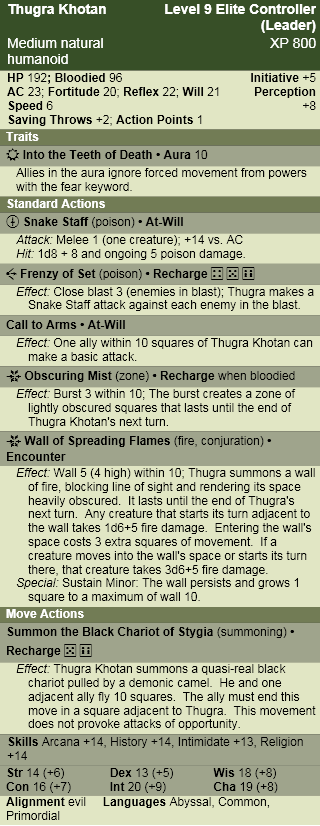
“Natohk faced the Cimmerian – inhumanly tall and lean, clad in shimmering green silk. He tossed back his veil, and Conan looked into the features he had seen depicted on the Zugite coin… Thugra Khotan’s skull-like countenance split in a mummy-like grin.” – Robert E. Howard, Black Colossus.
Lore
Nature DC 15: Thugra Khotan is an ancient Stygian sorcerer who put himself in a deep magical slumber when the city he ruled was overrun by invading barbarians. If he were to awaken, he would surely work to restore his lost glory and take revenge against the nations descended from his enemies.
Thugra Khotan in Combat
Thugra sees himself as a great general and leader of men. He enjoys using his magical abilities to control the battlefield and execute complex strategies and ambushes. His followers obey his orders without question, for they know that Thugra’s displeasure is far worse than anything their enemies can inflict.
The Stygian has no compunctions about withdrawing from a losing battle. After all, armies can be raised, servitors can be summoned, and if need be the sorcerer can seal himself away again and wait for his foes to turn to dust.
Encounters
Thugra Khotan is a master of ritual magic, especially the summoning and binding of demons, and is always accompanied by a barlgura bodyguard. In the years since his city’s downfall, the legend of his power spawned a small but dedicated cult who is now instrumental in recruiting for the sorcerer’s army. The ranks of this horde swell with a motley assortment of bandits, mercenaries, and thugs, lured by the promise of gold, glory and bloodshed.
Most of Thugra Khotan’s targets are well acquainted with the ancient sorcerer long before his minions storm a wall or batter a gate. The Stygian is a master of psychological warfare and takes great pleasure in tormenting his adversaries with sending and other magical forms of intimidation.
Notes
I admit I chose to make Thugra level 9 purely so that he could be teamed up with a barlgura lackey – just like he was in the story (well it wasn’t exactly a barlgura, it was an ape-demon, but I think the barlgura is close enough).
I wasn’t sure if I should make him undead or not since he’s described as looking like a mummy, but I don’t think he was (he was held in stasis in the ivory dome, he had mortal lusts and he was killed by a sword through the chest… I also wanted to differentiate him from a normal D&D lich). If an undead Thugra fits your game better it’s easy enough to change and doesn’t really impact anything.
Finally, the lore check uses the Nature skill simply because that’s the 4e convention for creatures with the natural origin. I think it’s much more appropriate to use the History skill instead (that’s happened before – more and more it looks to me like the knowledge skills and monster origins aren’t lining up as smoothly as I would like in 4e).
Random Encounters: Grindylow
January 18, 2011So at the suggestion of KaosEleQtric regarding my retrospective on Rifts, I’ve converted the grindylow to 4e D&D stats. The exercise reminded me of two things. First, just how much mileage you can get out of a random generator. If you’re stuck for an idea of a challenge to face your players it is definitely worth checking out the multitude of random generators online (if only for a thought experiment to get the juices flowing).
The second thing I was reminded of was just how great 4e handles monster creation. Don’t get me wrong, the system has its flaws, but when it comes to making new monsters its king (and I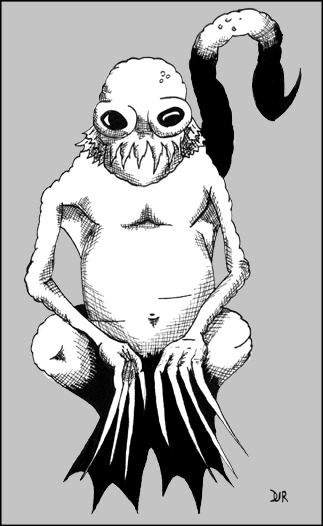 ‘m in love with the monster builder in the adventure tools). I really like the approach the rules foster to monster creation. You tackle the design from the perspective of what you want the monster to do, first and foremost (i.e. shoot eye beams, fly around, or in the case of the grindylow blind people, drag them into the water and sting them), and the end result is a monster that mechanically fulfills that vision. I love that goblins, kobolds, and orcs all feel different in combat because they are mechanically different from one another (now I just wish that the classes in 4e felt a little more different from one another). Could 3e handle any of the monsters I’ve created on this site? Of course it could, I just think it’s a lot easier in 4e (now when it comes to customizing already existing monsters 3e is definitely the king – I love the idea of adding class levels and advancing venerable monster specimens in size).
‘m in love with the monster builder in the adventure tools). I really like the approach the rules foster to monster creation. You tackle the design from the perspective of what you want the monster to do, first and foremost (i.e. shoot eye beams, fly around, or in the case of the grindylow blind people, drag them into the water and sting them), and the end result is a monster that mechanically fulfills that vision. I love that goblins, kobolds, and orcs all feel different in combat because they are mechanically different from one another (now I just wish that the classes in 4e felt a little more different from one another). Could 3e handle any of the monsters I’ve created on this site? Of course it could, I just think it’s a lot easier in 4e (now when it comes to customizing already existing monsters 3e is definitely the king – I love the idea of adding class levels and advancing venerable monster specimens in size).
With all the rumors of 5e floating around (which I think are premature personally), lets hope D&D keeps this approach to monster design.
The Grindylow
“When I was a lad my grandmother used to warn me away from the twisty bog, for that was the home of the grindylow. When I had seen my fifteenth winter I ignored her tales, as young men are wont to do, and set off into the bog with a group of ruffians in search of gold and adventure. Nary a one of them survived, all dragged beneath those black waters by the thing’s long, cruel claws, its tail cracking like a horseman’s whip. The grindylow had found us, and I’ll never forget that crying, screaming little boy I saw reflected in those hateful eyes.”
Lore
Arcana DC 15: Grindylow are malevolent fey that live in noisome bogs and other still bodies of water. They prefer to drown their prey, but are just as capable out of the water.
Arcana DC 20: The touch of pure silver burns the grindylow’s corrupt flesh, preventing it from healing. The creature’s magic aura befouls any water it stays in, earning the grindylow the enmity of Nymphs and Druids.
The Grindylow in combat
Grindylow tend to focus on weaker targets who they can easily blind and drag back to the water. They are slow witted creatures driven by an unceasing hunger for humanoid flesh and are incapable of formulating complex plans on their own.
Encounters
Grindylow are usually too cowardly to tackle a group of well armed heroes on their own, but are often pressed into service by smarter and more powerful creatures like bog and river hags. Grindylow like to hide at the fringes of combat, waiting for an opportunity to grab the wounded and drag them away from their allies.
Notes
If you’re going to use the grindylow in Gamma World add the extradimensional keyword to the monster’s description.
I ended up giving the grindylow regeneration, something the original version didn’t have, since I was emulating the only creatures in D&D with a weakness to silver: lycanthropes (which makes sense since the silver weakness in the Rifts version was emulating the Rifts version of lycanthropes).
The Tower of the Elephant
January 10, 2011Most fans of the Conan stories count The Tower of the Elephant among the best, and I can’t disagree. More important though is the obvious influence this story must have had on D&D. The premise of the adventure is classic D&D stuff: Conan hears a rumor in a bar, forms a party, and braves a monster and trap infested location for treasures which don’t turn out as he expected. And since this story predates the game by a few decades, I guess it would be more correct to say that D&D is classic Conan.
Spoiler Alert! All of these Hyborian age posts are going to be filled with spoilers. From the summary, to the monster stats they are going to ruin any surprises as to what the monster is, when they pop up in the story and how and why they are killed. You’ve been warned.
Summary
From the end of Conan’s career in The Scarlet Citadel, Howard takes us to the beginning, and a much younger and inexperienced Conan. The scene opens on the Maul, a dangerous maze-like section of an unnamed Zamorian city where city guards fear to tread and thieves rule the night. In a dimly lit drinking den Conan hears a Kothian kidnapper gossip of Yara the priest, who dwells in the elephant tower with a great magic gem known as the heart of the elephant. Conan doesn’t understand why a thief with any courage hasn’t simply taken such a treasure yet and the Kothian mocks his naiveté. Conan (even rawer than we’re used to seeing) takes offence and cuts the cur down where he stands. In the chaos following the fight, Conan strides out into the night, the target of his adventure clear.
In the gardens surrounding the tower Conan finds he is not alone in his endeavor. There is another trespasser in the garden by the name of Taurus, the self proclaimed ‘prince of thieves’. The two come to an agreement and proceed together – just in time to dispatch a group of ravenous lions that had been placed in the gardens as savage guards. Conan and Taurus scale the perilous tower and enter, but the lions are not Yara’s only defense. A monstrous spider hiding in the upper chamber poisons Taurus and almost slays the Cimmerian as well. Only Conan’s barbarian instincts see him through the fight alive.
Alone, he continues his quest for the jewel. In one of the tower’s rooms he finds a strange and monstrous creature with emerald skin and the head of an elephant. But instead of a climactic battle with this demon we are given something else. The creature is Yag-kosha, blinded and broken on the r ack – a thing to be pitied. Yag-kosha has been Yara’s prisoner for centuries, working his magic for the priest against his will, unable to escape even by taking his own life.
ack – a thing to be pitied. Yag-kosha has been Yara’s prisoner for centuries, working his magic for the priest against his will, unable to escape even by taking his own life.
The elephantine beast came from green Yag, across the cosmos, while Conan’s people were still primitive ape-men (the same Yag the seeds of Yogtha the Devil Flower were scattered from). Slowly, over vast spans of time his people died out until only Yag-kosha was left, now a shadow of his former self, indentured to the cruel tyrant Yara.
Yag-kosha sees in Conan a means for both liberation from his torture and revenge on the man who inflicted it. He instructs the barbarian to put him out of his misery by cutting out his heart and pouring the blood on the magical jewel he is linked to (the treasure Conan has risked so much to claim). The bloody task complete, Conan is to find Yara and present him with Yag-kosha’s final ‘gift’.
Not one to be squeamish about such tasks Conan obliges Yag-kosha and does as he was instructed. Taking the gem, Conan finds Yara in the haze of the yellow lotus. The dark priest is hostile and outraged at having his meditations disturbed, but goes silent when Conan delivers the heart of the elephant. The strange jewel enspells Yara, shrinking him to diminutive size before absorbing him. Inside the glass walls of the fantastic jewel Conan watches Yara trembling before a fully restored Yag-kosha.
Not sure if what he had experienced was real or not Conan steals away from the tower empty handed as the imposing tower shatters with the first rays of the sun.
Yag Starcaster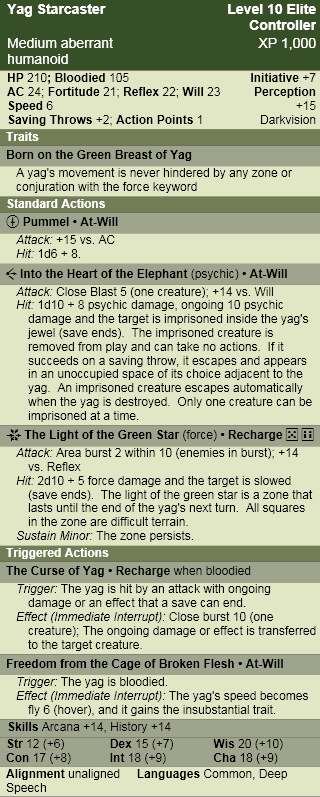
“Conan stared aghast; the image had the body of a man, naked, and green in color; but the head was one of nightmare and madness. Too large for the human body, it had no attributes of humanity. Conan stared at the wide flaring ears, the curling proboscis, one either side of which stood white tusks tipped with round golden balls.” – Robert E. Howard, the Tower of the Elephant
Lore
Dungeoneering DC 15: The Yag are a race of elephant headed, alien beings from the green star of the same name. Each Yag is bonded to a crystal, through which it works powerful magic. The Yag are extremely long lived, so much so that many consider them immortal and worship them as gods.
Dungeoneering DC 20: A Yag can die, but destroying its mortal shell merely frees the creature’s powerful, winged spirit. It is not known what caused the Yag to flee their home, but it must have been an awesome threat both physically and spiritually to send these beings across the void between the worlds.
Yag Starcaster in Combat
Yag are emotionless and methodical in combat. These creatures know that their physical forms are nothing but imperfect reflections of the spirit. For this reason a Yag does not fear death, and in many cases may even welcome it, if it furthers the creature’s goals.
Encounters
Yag are often the leaders of strange star-worshipping cults, perfecting their ancient magic and teaching it to their followers. They care little for the politics of the ‘lesser races’, but the pursuit of their alien goals often brings them and their followers into conflict with outsiders.
It is rumored that powerful star pact Warlocks can ritually bind a Yag into servitude. Such tales usually end with the Yag wreaking bloody vengeance on the Warlock who bound it.
Notes
I really liked the idea of the Yag shrinking PCs down and trapping them in its gem (what we used to call ‘minimus containment’, back in the day), so I cribbed parts of the devourer’s trap spirit ability to make it work. Since the creature is supposed to get more powerful when it dies I thought about making its freedom power work when it got to 0 hit points and adding a healing ability to it, but elite creatures have enough hit points already (especially since it gains insubstantial, it had the potential to make the combat too long). I figured making it ‘die’ when it got bloodied was probably a better call (and makes the creature die and be reborn at a better point in the combat).
I used dungeoneering for the lore check simply because that’s the 4e convention for creatures of the aberrant origin. If you’re not married to that convention then I would recommend using arcana instead, it just seems more appropriate for the astrological/alien bent of this creature than dungeoneering does.
Retrospective: Rifts
January 6, 2011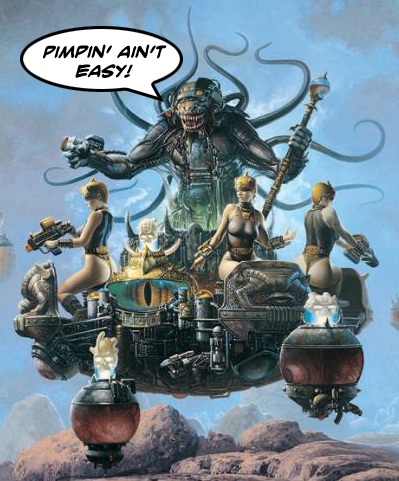 Now that I have the new Gamma World boxed set, I’ve been toying with the idea of using the rules to run a game set in the world of Rifts. In the way of research, I cracked open the Rifts books that I still had and took a stroll down memory lane. As I mentioned before, during the nineties I briefly cheated on my first rpg love (D&D) by having a brief but intense relationship with Rifts. My gaming group and I were a little more than halfway through our epic 2e Temple of Elemental Evil campaign, and realized that our original notion of rotating DMing duties each adventure was not going to pan out (I quote the back of the module, “hours of entertainment”). It was going to take all of high-school to finish (and it did). To keep things fresh, we occasionally took a break and tried out other settings (Dark Sun, Spelljammer, Al-Quadim), and games (TMNT, Top Secret). We were playing every week, so it was easy to find the time.
Now that I have the new Gamma World boxed set, I’ve been toying with the idea of using the rules to run a game set in the world of Rifts. In the way of research, I cracked open the Rifts books that I still had and took a stroll down memory lane. As I mentioned before, during the nineties I briefly cheated on my first rpg love (D&D) by having a brief but intense relationship with Rifts. My gaming group and I were a little more than halfway through our epic 2e Temple of Elemental Evil campaign, and realized that our original notion of rotating DMing duties each adventure was not going to pan out (I quote the back of the module, “hours of entertainment”). It was going to take all of high-school to finish (and it did). To keep things fresh, we occasionally took a break and tried out other settings (Dark Sun, Spelljammer, Al-Quadim), and games (TMNT, Top Secret). We were playing every week, so it was easy to find the time.
One of my friends wanted to try his hand at running a game and had just picked up Rifts. I was familiar with Palladium through TMNT, Heroes Unlimited and Robotech, so it wasn’t a stretch to try, but when I saw what character options the game had I was instantly sold. You can have a cyborg and a wizard in the same party? That’s cool… wait what’s that? YOU CAN BE A DRAGON?! After seeing that, I was convinced we would all play dragons, but my friend picked up the Rifts Conversion Book and Rifts Worldbook One: Vampire Kingdoms and there was so much cool crap it was overwhelming (there was one dragon in the party, but I ended up playing a vampire named Chopin whose coffin was hidden in his piano). We were hooked.
Fast forward to university and I was drifting farther and farther away from D&D. I kept my subscription to Dragon, but 2e was starting to feel stagnant. The only regular game I was running was Rifts, and even when the campaign was on hiatus the setting so intrigued me that I couldn’t help but roll up NPCs and create Rifts material (if you search the net you might find the very amateur font I made based on the diabolist’s runes – they even used it on the Palladium website for a while) in my spare time. Rifts is also the game that introduced my partner to role-playing, so for that I’ll always remember it fondly.
In spite of my enthusiasm, Rifts as a game system has a lot of problems. Reams have been written on the what, wherefore and why of this, but by grad school, the game’s warts were beginning to burn me out. It’s in vogue now to decry game balance as unnecessary (and perhaps 4e does fetishize it), but play Rifts for a few years and you’ll miss it. Maybe I’m an inadequate GM, but making interesting encounters that would challenge a party that included both a chiang-ku dragon temporal wizard and a plain old SDC operator was trying (in the end I encouraged SDC characters by giving them a ‘special item’ to start the game with – the longest running character, a mutant opossum, had Captain America’s shield). The fact that each new book seemed to have more powerful weapons, armor and character classes than the last just added to the balance issues (by the tenth book the glitter-boy power armor, the supposed final word in personal weaponry, was starting to look like a piece of junk).
As time wore on, I wasn’t spending my time creating anymore. Instead I was trying to think up house rules to make the game work. It got me down. Then something completely unrelated to Rifts happened that changed everything. D&D 3e was released. Suddenly, I remembered why D&D was my first love and what I had been missing all that time. I dropped Rifts like a hot potato and went running back to her. The new edition seemed to answer every problem that had plagued my Rifts campaigns: it had untrained skills, humans with mechanical advantages, and most importantly a single experience chart – because all the classes were worth playing.
Since then I’ve haven’t looked at the old Rifts books that much, so re-reading Erin Tarn’s gazetteer of North America was a blast, both as nostalgia and as inspiration (whether the Gamma World thing actually pans out or not). There was something else in the core Rifts book, tucked away at the back that I had completely forgotten about: a set of random tables for making supernatural monsters on the fly. As a GM I had absolutely loved these tables, not only were they fast and easy but they gave PC’s a good reason to take th e demon and faerie lore skill (each monster had a special weakness the skill could reveal). I was very disappointed to find out these tables were cut from the Rifts Ultimate Edition (don’t get me started on how disappointing this book is in general but the fact they would cut something useful like the monster generator and add in a page of rules for cyber knights to change the color of their psi-swords is a pretty clear illustration of why Ultimate Edition didn’t bring me back into the fold).
e demon and faerie lore skill (each monster had a special weakness the skill could reveal). I was very disappointed to find out these tables were cut from the Rifts Ultimate Edition (don’t get me started on how disappointing this book is in general but the fact they would cut something useful like the monster generator and add in a page of rules for cyber knights to change the color of their psi-swords is a pretty clear illustration of why Ultimate Edition didn’t bring me back into the fold).
Well, looking over the tables my dice started itching again and I couldn’t resist whipping up a supernatural predator. So after all the blather, I present the crunch: the grindylow.
The Grindylow
These dark and twisted faeries haunt bogs and lakes, preying on children and lone travelers who venture too close to their lairs. Although the grindylow prefer life underwater, they are amphibious and just as capable on land. Grindylow prefer dank and dismal surroundings and use their magic to befoul any waterway they occupy, earning them the enmity of nymphs and water sprites.
Grindylow are slow-witted and incapable of formulating complex plans. If food grows scarce they simply relocate, finding the quickest and easiest source of human flesh available. On Rifts earth, this is often in the sewer outside of a body chop shop, where they feast on the patrons’ discarded parts and the butchered remains of cyber-snatch victims.
The Grindylow – supernatural predator
Alignment: Diabolic
Attributes: IQ 6, ME 9, MA 4, PS 20, PP 18, PE 21, PB 2, Spd 12
M.D.C.: 80
Horror Factor: 13
P.P.E.: 40
Weight: 250 lbs (113 kg)
Size: 7 ft tall
Natural Abilities: swim 90%, track by sight 44%
Combat: Three attacks per melee (including one magical attack)
Damage: large retractable claws 3d6 M.D., prehensile tail with stinger 2d6 M.D.
Bonuses: +1 on initiative; +3 to strike; +2 to parry and dodge; +3 to save vs. poison and magic
Magic: Once per melee the grindylow can use either blind or spoil (this is a natural magical ability and not a spell, so it has no P.P.E. cost)
Psionics: None
Appearance: A squat gill-man with long, spindly arms and a prehensile tail
Average Life Span: 600 years
Habitat: Sewers, bogs, lakes and streams
Enemies: Water sprites and nymphs. The grindylow is fearful of well-armed groups.
Allies: Other creatures with a similar taste for flesh, and depraved individuals who use the grindylow as a man-eating ‘pet’.
Notes: The grindylow is vulnerable to weapons of silver, which inflict M.D. on the creature equivalent to the weapon’s S.D.C. damage.
Notes:
So after rolling its feeing habits (a solitary hunter who feeds on humans), and natural abilities (swimming), I figured the grindylow from English folklore fit the bill nicely (also the villains in the great China Mieville book, The Scar). That’s what I love about a set of random tables like this; many times the random results will point in a specific direction or remind you of something cool that’s been squatting in a dark corner of your brain that you haven’t thought about in a long time. Sure, you sometimes get something that doesn’t make a whole lot of sense (say a 25 ft tall predator that hunts in packs of 36 that breathes flames and is vulnerable to fire), but as long as the process isn’t too involved its easy to scrap it and start again (this time I got medium sized creatures who hunt in small packs, cast fireball every round and are vulnerable to symbols of goodness – instant hound of hell).
The Scarlet Citadel – Part Two
January 2, 2011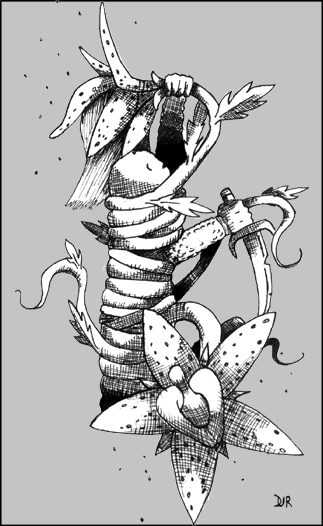 This is the second creature from Robert E. Howard’s The Scarlet Citadel. For the summary of the story as well as the creature from the pit, click here.
This is the second creature from Robert E. Howard’s The Scarlet Citadel. For the summary of the story as well as the creature from the pit, click here.
Spoiler Alert! All of these Hyborian age posts are going to be filled with spoilers. From the summary, to the monster stats they are going to ruin any surprises as to what the monster is, when they pop up in the story and how and why they are killed. You’ve been warned.
Yothga the Devil Flower
In the cold, black depths of the cosmos hangs the star known to warlocks as Yag the accursed. From here, yothga the devil flower spreads its seeds into the world to nourish itself on the thoughts and memories of intelligent creatures. It is said the seeds will only germinate in the lowest, most vile reaches of the underworld, and that as the plant grows, horrible monsters take refuge in its roots. The devil flower feeds by immobilizing its prey in its tendrils and showering them with potent sleeping spores. Once asleep yothga uses its alien flowers to siphon a victim’s thoughts and memories until only an empty soulless shell remains – a slow and ghastly process that can take a decade or longer.
Only those powerful and mad enough to make a pact with the powers of the outer dark know the secrets of cultivating one of yothga’s stalks. For these individuals the devil flower is a powerful tool of unending torture and imprisonment.
Notes
The devil flower is one of the cr eepier creatures of Tsotha-lanti’s dungeon and plays a much more pivotal role in the plot than the thing from the pit, so that alone demanded that I should create statistics for it. But as a stationary plant that didn’t eat enemies so much as imprison them, it seemed much more like a hazard than a monster. The monster summoning comes from Pelias’ comment that pulling the plant up by the roots is dangerous because Conan “…might have found things clinging to the roots against which not even your sword would prevail.” I used the ghoul and wretch of Kyuss simply because they were minions of the right level (I also felt they fit the whole ‘roots in the underworld’ thing), but any level 13 minion would do (a minion balances out the XP of the devil flower being killed with a single action, I think a full fledged creature would be too powerful). Even though the story has yothga putting people to sleep forever (until the plant is removed by an outside force), I thought that in the context of a D&D adventure it was just too deadly, so I added the option of using a healing surge to wake up. If you were running a very gritty and deadly game you could remove that option to reflect the source material more faithfully.
eepier creatures of Tsotha-lanti’s dungeon and plays a much more pivotal role in the plot than the thing from the pit, so that alone demanded that I should create statistics for it. But as a stationary plant that didn’t eat enemies so much as imprison them, it seemed much more like a hazard than a monster. The monster summoning comes from Pelias’ comment that pulling the plant up by the roots is dangerous because Conan “…might have found things clinging to the roots against which not even your sword would prevail.” I used the ghoul and wretch of Kyuss simply because they were minions of the right level (I also felt they fit the whole ‘roots in the underworld’ thing), but any level 13 minion would do (a minion balances out the XP of the devil flower being killed with a single action, I think a full fledged creature would be too powerful). Even though the story has yothga putting people to sleep forever (until the plant is removed by an outside force), I thought that in the context of a D&D adventure it was just too deadly, so I added the option of using a healing surge to wake up. If you were running a very gritty and deadly game you could remove that option to reflect the source material more faithfully.
Random Encounters: Powered Armor of the Barrier Peaks
December 24, 2010 Synchronicity (not just a great song by the Police, it’s also the most powerful weapon in Robotech) is to thank (/blame) for this post. Right around the time I read this D&D Alumni article about using the new Gamma World game to convert the classic module Expedition to the Barrier Peaks to 4e, I was exposed to the gonzo magnum opus, Booty and the Beast, over on Mr. Lizard’s gaming site. I was inspired.
Synchronicity (not just a great song by the Police, it’s also the most powerful weapon in Robotech) is to thank (/blame) for this post. Right around the time I read this D&D Alumni article about using the new Gamma World game to convert the classic module Expedition to the Barrier Peaks to 4e, I was exposed to the gonzo magnum opus, Booty and the Beast, over on Mr. Lizard’s gaming site. I was inspired.
It’s no coincidence (eh, synchronicity), that these two things should gel in my mind. Old School idol Erol Otus did the art for both products and both feature technological gadgets and weapons to incorporate into your fantasy rpg. The art and the crazy ideas in these two products are inspiring. It reminds me of a time when my mind was more open and new ideas were as easy as flipping open a comic, or turning on the TV and adding a few more ingredients to the mental stew. Sometimes it worked, sometimes it didn’t, but I was never afraid to try. Then I became a lot more serious about rpgs.
I have a confession. As cool as I thought it was (and I even owned a used 1e copy of Gamma World), I’ve never played Expedition. There’s a reason. When I was learning the ropes of DMing in public school, if I saw something I liked in one of the books, my players would find it (which led to the party’s ranger carrying a brace of magic short swords including a luck blade, nine-lives stealer, frostbrand, and more). While this was its own kind of fun, as I got older it started to lose its luster and I tried very hard at being a more serious DM. For me, when the players got their hands on machine guns and rocket launchers (putting the rpg in rpg) it was a sign that the game had gone to crazy town and the campaign was about to implode. So as much as, ‘it’s the adventure where you get to fight robots and pick up lasers’, appealed to me, it also had a giant blinking warning sign above it. Dungeons and Dragons was a tightly controlled universe that didn’t need game breaking technology floating around for the players to trip over (in high school I had a reputation as being pretty stingy with magic items). But there’s a part of me that’s very attracted to genre crossing (probably influenced by Marvel comics’ approach), which is probably why I found Rifts so refreshing in the 2e days (my love affair with Palladium is fodder for another post).
Skip ahead many years (too many) to the present. My head full of Otus Galactic Dragons and Bart Carroll issues the challenge to stat up the powered armor from Expedition. Now, I don’t own the new Gamma World, so I don’t know what an ‘omega tech’ card is, but I wanted to see if I was able to make a version of the armor that could be brought into a 4e game without destroying it. I decided to make it an artifact, since it appealed to the DM in me (artifacts are unique, easily controlled by the DM and are only in the game a limited time) and I thought the concordance mechanic was a good abstraction of the players trying to figure the thing out.
I’ve rambled on far enough without any goods to show for it, so without further ado I give you the powered armor of the Barrier Peaks.
The Powered Armor of the Barrier Peaks
Powered armor of the Barrier Peaks is appropriate for characters in the middle of the paragon tier and upward.
Goals of Powered Armor
• This artifact is not sentient and so has no goals of its own.
Roleplaying Powered Armor of the Barrier Peaks
Powered armor of the Barrier Peaks is different than other artifacts. It cannot communicate with its wearer and has no specific agenda it was created to pursue. It is the product of a foreign science even the most powerful archmagi find impossible to understand. Mastery of the item comes through experimentation and tinkering. Damaging the armor and allowing its power source to run unchecked will lead to the ruin, not just of the armor’s owner, but of everything around her.
Powered Armor of the Barrier Peaks Lore
History DC 20: Legend holds that the infamous steel clad dungeons of the Barrier Peaks were formed when the comet Warden crashed into the mountains decades ago. The winding passages of these mysterious halls are filled with exotic treasures and dangerous creatures seen no where else in the world. Perhaps the greatest treasure of all is the fabled suit of powered armor that is said to lie here, buried with the remains of the advanced race that built it.
History DC 25: Sages speculate that the alien magic used to create the powered armor of the Barrier Peaks is the same that drove the warlord Lum insane in his quest to build the gargantuan machine that bears his name.
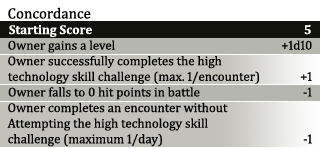
Pleased (16-20)
“Your spells are quaint superstitions next to the technological might of super-science.”
The armor’s enhancement bonus increases to +5.
Power (Daily): Fusion Blast. Standard Action. Close burst 5 (enemies in burst); Constitution vs. Reflex; Hit: 4d6 + Constitution modifier fire and force damage and ongoing 5 fire damage.
Satisfied (12-15)
“The secrets of this strange magic begin to open up to me.”
Power (Daily): Force Field. Immediate Interrupt. You can use this power when you are hit by an attack that causes damage. You gain resist all 10 + Constitution modifier until the end of your next turn.
Normal (5-11)
“I sense great power here fore those with the wisdom to use it… and great danger for the ignorant.”
The wearer is just beginning to understand the armor’s potential. Careful testing of its capabilities in combat will unlock greater functions.
Unsatisfied (1-4)
“I know I can figure this thing out. I just need more time.”
The wearer has taken the armor for granted, using its capabilities without bothering to try and understand its systems. Overloads and malfunctions are becoming more commonplace.
The armor’s enhancement bonus drops to +3.
Special: The first time each day a critical hit is scored against you, you suffer ongoing 10 lightning damage (save ends). Aftereffect: you are weakened (save ends).
Angered (0 or lower)
“What does this button do?”
The armor is severely damaged and it is only a matter of time before a 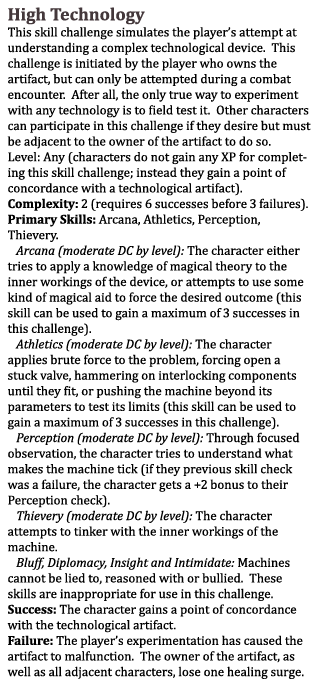 complete critical systems failure.
complete critical systems failure.
The armor’s enhancement bonus drops to +2.
Special: The first time each day you score a critical hit make the following attack as a free action: critical malfunction; close burst 4 (allies in burst); Constitution vs. Reflex; Hit: 4d6 + Constitution modifier fire and force damage.
Moving On
“The flux capacitor is completely drained.”
All machines eventually break down, burn out, or run out of fuel. Even a fusion powered suit of armor. How and when the armor moves on depends on how well the artifact’s owner can control it.
When the powered armor of the Barrier Peaks reaches its limit, if it is at least satisfied, the owner is able to power it down during a non-critical time (during an extended rest, for instance) and avoid any catastrophes. In addition, time spent breathing the nanite filtered air has had beneficial side effects. The owner gains a permanent +2 bonus on Endurance checks, and can re-roll (keeping the higher roll) any failed Endurance check made to avoid suffocation or drowning damage.
An unsatisfied or angered suit of armor goes into critical meltdown at the most inopportune time. The armor explodes and makes the following attack (which includes the owner), close burst 5 (all creatures in burst); +20 vs. Reflex; Hit: 3d10+6 fire and force damage, and the target is knocked prone; Miss: half damage.
Notes:
I wanted to use a skill challenge to increase concordance because I felt it nicely replicated the complex flow charts that Expedition used to ‘simulate ignorance’ in the proper use of technological items. Players could experiment with these items during downtime, but the charts had some dangerous outcomes so there was real risk involved (losing charges, getting hurt or the item blowing up). Since my version of this item was an artifact and didn’t have charges, and given how healing and extended rests worked in 4e, that meant I would need to tweak things in order to preserve that element of danger. I felt a simple solution would be to make a skill challenge that could only be undertaken during a combat encounter. That way, if the players want to increase their understanding of the armor they have to be willing to sacrifice some of their combat actions (not to mention potentially losing a healing surge).
The picture is a twenty-one gun (or maser) salute to Erol Otus’ illustration of the power armor in Expedition. Somehow the 1970’s science fiction imagery of power armor just seems to fit D&D better than the anime aesthetic (although I do picture Gigantor as the mighty servant of Leuk-O).
The Scarlet Citadel – Part One
December 22, 2010The Scarlet Citadel might not be the best Conan story ever written, but I think that page for page, it has more monsters than any other (and they’re some of the coolest as well). That made it pretty hard to narrow it down to a single creature to showcase… so I chose two instead (it’s the holidays). Like the title says, this is part one – I’ll post another fiend later in the week.
Spoiler Alert! All of these Hyborian age posts are going to be filled with spoilers. From the summary, to the monster stats they are going to ruin any surprises as to what the monster is, when they pop up in the story and how and why they are killed. You’ve been warned.
Summary
The second published Conan story takes place after the Phoenix on the Sword. Now that Conan has dealt with his internal enemies, he must now face the external threats to his kingdom. The tale begins with Conan on the field of battle, betrayed by Aquilonia’s neighbor, Ophir, to the King of Koth. Outnumbered his knights are quickly cut down and Conan is captured by the power behind the throne of Koth, the dark wizard Tsotha-lanti. The Kothians spirit Conan back to their capital and imprison him in the dungeons of Tsotha’s infamous scarlet citadel. Here Conan is given an ultimatum: continue to rule Aquilonia as a satrap of Koth or face death at the hands of the horrors below Tsotha’s citadel. As we knew he would, Conan rejects the offer (to put it mildly).
In the dungeons Conan encounters a huge albino serpent, a flopping tentacled thing whose sobs sound too human, an invisible floating creature (that mouths noiseless obscenities at him), and a vampiric plant that feeds on thoughts and memories. From the clutches of the devil plant Conan frees another sorcerer, Pelias, Tsotha-lanti’s chief rival (who might be just as bad as Conan’s captor).
With Pelias’ aid Conan flies back to Aquilonia astride a great bat winged monstrosity just in time to retake his capital and rally the troops. At the head of his army Conan rides southward to meet the armies of Ophir and Koth head on. In the ensuing slaughter the kings of both enemy nations are cut down and Pelias exacts grisly vengeance on Tsotha-lanti.
“Its unstable outlines somewhat suggested an octopus, but its malformed tentacles were too short for its size, and its substance was a quaking jelly-like stuff which made him physically sick to look at. From among this loathsome gelid mass reared up a frog-like head, and he was frozen with nauseated horror to realize that the sound of weeping was coming from those obscene blubbery lips. ” – Robert E. Howard, the Scarlet Citadel
Lore
Dungeoneering DC 20: The thing from the pit is the result of the wizard Tsotha-lanti’s twisted experiments with the Far Realm. Its form is so loathsome that few can overcome their disgust long enough to get within striking distance, and its cackling laugh can unnerve even the most stalwart of warriors.
The Thing from the Pit in Combat
The thing from the pit revels in the fear and disgust it inspires; taking great delight in driving its enemies into deadly traps and other hazards.
Encounters
There are few creatures that can stomach the company of the thing from the pit save mindless oozes and other, equally deformed, aberrations. The latter find the thing from the pit’s ability to shepherd prey across the battlefield invaluable.
Notes
This creature doesn’t play that large a role in the story but it really grabbed my attention. Its appearance was so bizarre it was hard to ignore, and more importantly, it freaked Conan out so much that he flees rather than try to fight it. It made Conan run away. This is the same guy who earlier in the story was able to hold perfectly still while a giant snake reared over him dripping acidic burning venom onto his legs. I wanted the thing from the pit’s powers to reflect that. The creature isn’t much of a threat on its own, but you combine it with other creatures, hazards and traps and I think it becomes quite deadly (in the story it almost gets Conan to fall down a well in his flight from it).
Even though this story takes place after the phoenix on the sword, I decided to make it a lower level than the slave of the ring – Tsotha-lanti’s creation just doesn’t end up hurting Conan like Thoth-Amon’s summoned demon did.
In terms of the picture I found it quite a challenge to draw, and going by Howard’s description it went through a few iterations. In the end I opted for a less true octopoid body and instead drew inspiration from Jim Holloway’s illustration of the yochlol from the 1e Monster Manual II.
The Phoenix on the Sword
December 14, 2010For Monsters of the Hyborian Age, I’m going to be covering the stories in the Complete Chronicles of Conan in publication order (coincidentally the order that they appear in the book) rather than the chronological order of Conan’s life. There are a few reasons for this. The first is that the chronological order is highly contested; with at least 3 different versions (I’m partial to Dale Ripkke’s). The second reason is that publication order is probably the order that they were intended to be read (imagine watching all 6 Star Wars films in chronological order – all of the anticipation and mystery of the original trilogy would make no sense). Finally, like the ‘Bond rule’ (the first actor you see playing Bond is the one whom you feel portrays him best), this is the order that I read them in so it subjectively just feels right to me.
Spoiler Alert! All of these Hyborian age posts are going to be filled with spoilers. From the summary, to the monster stats they are going to ruin any surprises as to what the monster is, when they pop up in the story and how and why they are killed. You’ve been warned.
Summary
The first Conan story, oddly enough, begins with the barbarian towards the end of his career. He is middle-aged and has become king by his own hand over the most powerful nation in the world, Aquilonia. But it is not an easy rule. A group of four influential conspirators works behind the scenes to end the new king’s rule and replace him with one of their own. While Conan was first hailed as a savior for killing the tyrant Numenides, the public (encouraged by the ‘rebel four’) chafes at being ruled by a foreigner. To this end the rebel four uses Ascalante, a deposed nobleman and his slave Thoth-Amon, once a powerful Stygian wizard, but bereft of magic since the loss of his powerful ring.
The rebel four plans on assassinating Conan with their own hands while he is defenseless. As the tangled conspiracy unfolds we learn that Ascalante plots against the rebel four even while he helps them, hoping to betray them at the last moment. Likewise his slave, Thoth-Amon plots against his master for the humiliation he has suffered at Ascalante’s hands.
While the rebel four and Ascalante put their plan into motion, fate deals two wild cards. First Thoth-Amon finds his magic ring and uses it to summon a powerful demon to track down and destroy Ascalante. Second, Conan is visited in a dream by the ghost of the sage Epemitreus who warns him of the im pending assassination and imprints his sword with the mystical symbol of the phoenix.
pending assassination and imprints his sword with the mystical symbol of the phoenix.
All threads come together in the king’s bedchamber as Ascalante and the rebel four find Conan awake and ready for them. Before battle can be joined Thoth-Amon’s demon enters the fray, destroying the would-be assassins and attacking Conan. Using his now magical sword, the king is able to slay the unstoppable beast and send it back to the abyss.
The Slave of the Ring
“Its outline was not unlike that of a gigantic baboon, but no such baboon ever walked the earth, not even in Stygia… The hideousness of its face transcended mere bestiality. It might have been the face of an ancient, evil mummy, quickened with demoniac life. In those abhorrent features the outlaw’s dilated eyes seemed to see, resemblance to the slave Thoth-Amon. Then Ascalante’s cynical and all-sufficient philosophy deserted him, and with a ghastly cry he gave up the ghost before those slavering fangs touched him.”
-Robert E. Howard, the Phoenix on the Sword
Arcana DC 20: The slave of the ring is a shadowy demon bound to a mystical talisman dedicated to the Stygian god, Set. Brought forth from the ring by means of a foul ritual, the demon serves its master as a peerless tracker and assassin.
Arcana DC 25: Woe to anyone who meets the slave of the ring’s terrible gaze, for its swirling yellow orbs have the power to shrivel a mortal’s soul in their baleful radiance.
The Slave of the Ring in Combat
Once the slave of the ring has its target’s psychic scent it is nearly impossible to evade. The demon stalks its prey, waiting until its target is distracted (typically in combat) to strike. It takes full advantage of its advanced mobility, skirting around defenses and rending softer opponents with their deadly talons.
Encounters
The slave of the ring is conjured into the world at the behest of its master, usually a powerful Wizard, Warlock, or Cleric (Yaun-Ti spellcasters favor the summoning of the slave of the ring to dispatch political opponents). Such a master might send other servants to accompany the demon (usually skirmishers or lurkers) or attend personally to ensure it fulfills its task.
Notes
When Conan fights the slave of the ring, he feels more like an upper Paragon tier character rather than an epic one (becoming king by your own hand feels more ‘paragon path’ than ‘epic destiny’), so I chose to make the creature a level 15 challenge. The demon’s limited invulnerability trait is meant to emulate its resistance to normal weapons and its vulnerability to Conan’s enchanted blade. I wanted to play around with power sources, since I haven’t really seen anything that makes use of those keywords. If there are a lot of PC’s in the party with these power sources you should probably increase the resistance to 15. If there are few PC’s you might want to place a magic weapon in the adventure with a trait that makes all attacks with it have the arcane or divine keyword (inscribed with a phoenix of course).
These Are A Few Of My Favorite Things
December 9, 2010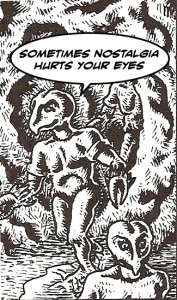 The blog’s background image is an homage not just to my favorite D&D monsters, but also to my favorite old school artists. The images of early D&D products really captured my imagination as a child, so part of my love for them is pure nostalgia. When I picture a purple worm, in my head it has eyes (the memory is also wrapped up in playing the Dungeon! boardgame while listening to Prince’s Purple Rain as well, but that’s another story), even though the new-style, more alien looking purple worm looks a lot cooler. Now I’m not slagging the art used in rpgs now, without question it is of a much higher technical standard (and some old school art is abysmal, take a look at the crabman from the original Fiend Folio). Wayne Reynolds, for example, is an incredible artist (I especially dig his ‘wall of action’ stuff, like the 3.5 DM screen Paizo put out), but there’s no way in hell I can emulate the style of Wayne Reynolds, I’m just not that good (in fact I’m not really an artist at all). But that’s also part of the attraction of old school art. Looking at an early Erol Otus or Bill Willingham picture I get the impression that with enough practice and a little luck I could draw like them. In a hobby that emphasizes do-it-yourself and fan-created material this kind of realistic goalpost gives the pieces special meaning. Even though I’ve never met them, it created a special kind of bond between me and the D&D artists of my childhood. In the end it’s probably just a fancy way of justifying my nostalgic over attachment to these images and my poor art skills, but hey isn’t that what blogging’s all about?
The blog’s background image is an homage not just to my favorite D&D monsters, but also to my favorite old school artists. The images of early D&D products really captured my imagination as a child, so part of my love for them is pure nostalgia. When I picture a purple worm, in my head it has eyes (the memory is also wrapped up in playing the Dungeon! boardgame while listening to Prince’s Purple Rain as well, but that’s another story), even though the new-style, more alien looking purple worm looks a lot cooler. Now I’m not slagging the art used in rpgs now, without question it is of a much higher technical standard (and some old school art is abysmal, take a look at the crabman from the original Fiend Folio). Wayne Reynolds, for example, is an incredible artist (I especially dig his ‘wall of action’ stuff, like the 3.5 DM screen Paizo put out), but there’s no way in hell I can emulate the style of Wayne Reynolds, I’m just not that good (in fact I’m not really an artist at all). But that’s also part of the attraction of old school art. Looking at an early Erol Otus or Bill Willingham picture I get the impression that with enough practice and a little luck I could draw like them. In a hobby that emphasizes do-it-yourself and fan-created material this kind of realistic goalpost gives the pieces special meaning. Even though I’ve never met them, it created a special kind of bond between me and the D&D artists of my childhood. In the end it’s probably just a fancy way of justifying my nostalgic over attachment to these images and my poor art skills, but hey isn’t that what blogging’s all about?
My favorite things from left to right:
Eye of the Deep: Beholders are one of D&D’s most iconic monsters, and I’ve always felt that its undersea cousin needed a bit more love. Before I knew any better I thought the eye of the deep was more powerful than the beholder – it had pincers and eye rays! (Inspired by Jean Wells’ illo. from the Monster Manual).
Red Dragon: They’re in the game’s name, you can’t do a picture featuring D&D monsters and not include them… plus, I really like dragons. (Inspired by any Jeff Easley dragon – including Jeff Easley in here kind of busts my whole ‘I could draw like them’ idea. There’s no way I could really emulate his style but I absolutely adore his paintings so I at least tried to capture the form of his dragons).
Water Dragon (silhouette): I’m actually not sure what kind of dragon this was. It could just as easily been a green dragon, but it’s hard to tell. (Inspired by Erol Otus’ cover for the Basic Dungeons and Dragons rulebook).
Umber Hulk: Once upon a time umber hulks were hulking. And for the record the color scheme is not inspired by (awesome) Olympic mascot Quatchi, I was going more for the rubber umber hulk made by LJN Toys in the 80’s. (Inspired by Jeff Dee’s illo. from the module The Ghost Tower of Inverness).
Jubilex: The dungeons of D&D are teeming with a cornucopia of oozes and slimes. If I’m going to draw a picture of one why not go for the granddaddy of them all. (Inspired by David A. Trampier’s illo. from the Monster Manual).
Stirge (silhouette): As a kid I spent a lot of summers in mosquito infested northern Ontario, so these bloodsuckers hold a certain resonance with me. (Inspired by David Sutherland III’s illo. from the Monster Manual).
Violet Fungi: With so many fungal based monsters in the game, I blame D&D for giving me the paranoid belief that eating mushrooms will infect me with their spores. (Inspired by Erol Otus’ illo. from the module Expedition to the Barrier Peaks).
Astral Dreadnought: This behemoth (not really to scale), never got a set of official stats until 2nd Edition even though it graced the cover of the Manual of the Planes. (Inspired by another great Jeff Easley painting).
Bugbears: While I was DMing The Temple of Elemental Evil in high school, the rules for reinforcing the forces of evil combined with the long healing times of the PC’s to create a population explosion of these critters. Ever since bugbears and I have had a bad reputation. (Inspired by Erol Otus’ illo. from Hackmaster).
Purple Worm: Better than a Shai-Hulud. (Inspired by David Sutherland III’s illo. from the Monster Manual).
Mind Flayer: Saved the best for last. Brain eating, mind controlling, tentacle creatures from the bowels of the earth. What’s not to love? (Inspired by the Bill Willingham illo. from the module Descent into the Depths of the Earth).
